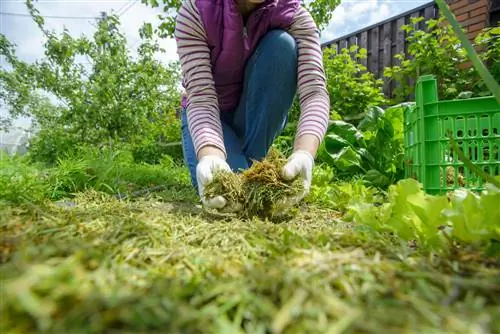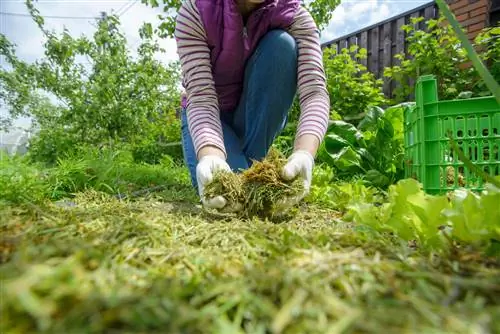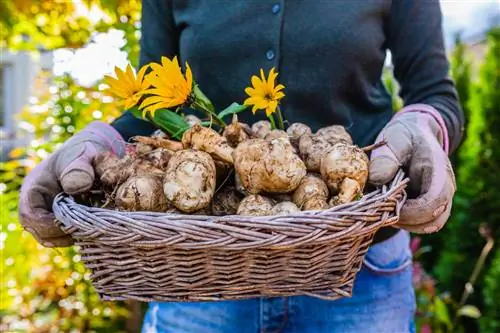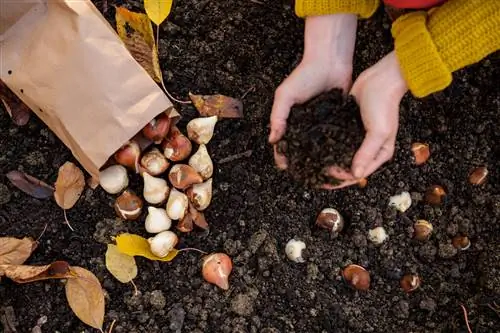- Author admin [email protected].
- Public 2023-12-16 16:46.
- Last modified 2025-01-23 11:22.
In June it is time to prepare the garden for long periods of heat in midsummer. This can be done by mulching with hay, straw or grass clippings to protect the soil from drying out. Leaves close to the ground on tomatoes and cucumbers can be cut and shoots removed. Grape vines also enjoy thinning so that the fruits can ripen well.

What are the most important gardening tasks in June?
June is all about sowing late vegetables, harvesting lettuces, kohlrabi, beans, herbs and strawberries as well as planting Brussels sprouts, kale and summer lettuces. Cutting herbs and flowering perennials, weeding and watering are also important tasks.
Summary
- Sowing: late varieties of carrots and kohlrabi, bush beans, winter leeks, bulbous fennel, radishes, radishes, lettuce, autumn and winter salads (radicchio, endive, sugar loaf); fast-growing herbs such as chervil, cress, dill, rocket, borage and savory; fast-growing summer flowers such as cherries, reseda, marigolds, wildflowers and candytufts
- Harvests: Salads, kohlrabi, radishes, radishes, broad beans, pointed cabbage, early cauliflower, savoy cabbage, new potatoes, herbs, strawberries; Asparagus and rhubarb until June 24th
- Plants: Brussels sprouts, kale, winter leeks, celery, summer lettuce, ice cream lettuce, lettuce
- Propagate: Head and shoot cuttings
- Cutting: Herbs before flowering; flowering perennials and summer flowers after flowering (avoid seed formation); young fruit trees and vines, lawns and deciduous hedges (e.g. hornbeams, privet, barberries)
- Other gardening tasks: Pulling weeds; Chop and mulch beds; Pile up the potatoes, leeks and peas, pick out the tomatoes and tie them up; prick out young plants that are too close together; tying and supporting tall perennials; collect rainwater; take protective measures against pests and diseases; Water and fertilize regularly
Sowing in June
- Vegetables: What is to be harvested in autumn and winter must be sown now. These include in particular these types of vegetables: late carrots, last bush beans, winter leeks, late varieties of kohlrabi, bulbous fennel, radishes, radishes and lettuce. Above all, now is the time to sow autumn and winter salads such as radicchio, sugar loaf and endive.
- Herbs: Do you still have some space in beds, borders or pots? Then sow a few more fast-growing herbs such as chervil, cress, dill, rocket, borage and savory.
- Summer flowers: At the beginning of June you can sow a few summer flowers with a quick development time. They bloom later and provide a splash of color in the garden when the previously sown flowers have already begun to wilt. Scented stoneweed, reseda, marigolds, maiden in the green and candytufts are well suited.
Harvests in June
- Vegetables and potatoes: There is a lush harvest in June. Salads, kohlrabi, radishes, radishes, broad beans, pointed cabbage, formerly cauliflower and savoy cabbage are now particularly suitable for the kitchen or for preservation. The harvest time for asparagus and rhubarb, however, traditionally ends on June 24th, St. John's Day. If the weather has been mild up to that point, the first early potatoes can often be harvested.
- Herbs: Annual and perennial herbs such as chives, borage, dill, parsley, chervil, cress, rocket, pimpinelle, sorrel, lemon balm, tarragon, hyssop, etc.a. are now well advanced in the beds and pots and can be harvested little by little. If the weather is good, you can now dry, freeze or pickle some herbs for the winter.
- Strawberries: The first red strawberry fruits entice you from the strawberry patch and can be picked. To keep the fruit clean and dry (and not eaten by hungry slugs), you should place straw between the rows of strawberries.
Plants that bloom in June
In June everything is green and blooming everywhere. However, these flowers and perennials are now showing off their splendor in a particularly lush way:
- Alpine and swamp forget-me-nots
- Astilbene
- Loosestrife
- Clematis (e.g. Clematis montana)
- Monkshood
- Foxglove
- Knapweeds
- Goldfelberich
- Sheaf of Gold
- Catnip
- Lavender
- Daisies
- Carnations
- Peonies
- larkspur
- Roses
- Coneflower
- Star Umbels
- Storksbill
- Daylilies
- Thyme
- Forest Goatbeard
- Ornamental sage, garden sage
Planting and propagating in June
- Plants: On recently harvested areas - for example early potatoes - you can plant Brussels sprouts and kale in the now free areas. The planting time is now also good for winter leeks, celery, summer lettuce, ice cream lettuce and lettuce. You can also plant perennials and shrubs grown in containers: in June it is not so hot that the plants suffer heat shock. In addition, the rooting that has already taken place ensures that the plants grow quickly and can absorb water.
- Propagate: June is the right month to cut and root head cuttings, e.g. B. in a water glass. If you want to get seeds yourself, for example from summer flowers or herbs, you should let them bloom and not cut them after flowering. But be careful that the ripe seed capsules do not sow themselves - unless self-sowing is desired.
Cutting in June
- Herbs: Sage, thyme and lemon balm in particular should now be cut back, otherwise these herbs will begin to bloom and lose their aroma.
- Grapevines: Summer pruning of grapevines is due in June. In doing so, shorten all supporting canes above the top fruit base to around three to four leaves. The shoots that do not bear grapes are cut out from July.
- Young fruit trees: Young fruit trees also need summer pruning. This is not necessary for older fruit trees, but you should remove some of the fruit from high-yielding specimens. This is especially important for apples and pears so that the other fruits can develop better. The trees often shed some of the excess fruit on their own; experienced gardeners refer to this phenomenon as “June Fall”.
- Summer flowers and perennials: To ensure that summer flowers and perennials bloom for as long as possible, you must regularly pluck out wilted flowers and leaves. Each seed takes energy and prevents the formation of new flower buds. This is especially true for all balcony flowers and potted plants. Delphiniums and lupins must be cut back after flowering; They then develop a beautiful bloom in late summer.
- Roses: For the more frequently blooming rose varieties, cut off all withered flower heads below the top two leaves. Single-blooming roses, especially historic shrub roses, retain their rose hips.
- Lawn: The grass also grows particularly lush in June. Cut the lawn regularly; the cut grass, when slightly dried, can be used as a mulch on the crop and ornamental plant beds.
- Hedges: Towards the end of June, hedge trimming begins on deciduous trees such as hornbeam, privet and barberry.
Plant diseases and pests in June
- Powdery mildew: To prevent powdery mildew - also known as "fair weather mildew" - you can spray horsetail broth, garlic tea or leaf-strengthening commercial preparations. Immediately remove already infected top shoots, for example on gooseberries, as well as diseased leaves, for example on cucumbers.
- Rust diseases: Preventive sprays with horsetail tea, tansy tea, algae preparations and stone dust help against rust fungi, which often manifest themselves as leaf spots. Here too, you should remove diseased leaves immediately!
- Aphids: Numerous beneficial insects hunt aphids. Therefore, be careful with sprays, as these also affect beneficial insects such as ladybirds etc. If necessary, the aphid infestation can be contained by spraying with tansy, wormwood or rhubarb leaf tea.
- Vegetable flies: Close-meshed special nets that are spread over endangered vegetable plants (e.g. carrots) protect against vegetable flies.
- Potato beetle: Collect the yellow-striped potato beetles, including eggs and larvae, from infected plants.
- Bigmouth Weevil: These little animals can only be caught in the dark. The larvae can be found in the soil next to wilting plants. Also spray tansy or wormwood tea on the soil.
- Apple moth: This butterfly lays its eggs directly on the apple fruits. You can spray small trees with wormwood or tansy tea as a preventive measure to mask the attractive smell of the fruit.
- Raspberry beetles: Raspberry beetles sit in the flowers of the berry bushes. Shake the rods over a bucket and the beetles will fall into it.
- Gooseberry sawfly: Early, i.e. H. Before the bushes are bare, you must collect or shake off the larvae of the gooseberry sawfly. Spritz with tansy tea or dust with stone powder.
More gardening work in June
- Care for beds: Weeds also seem to grow at twice the speed in June. Try to remove the wild herbs from the beds as early as possible - so that they don't overwhelm the young vegetable plants. If the seeds are planted too closely, you must now ensure that there is a distance between them. Pluck out excess plants from carrots, salsify, beets and radishes. Potatoes, leeks and peas need to be piled up again. Bush beans and cabbage also do well with a light mound of earth. Open soil needs to be hoeed more often. Now pour the finished nettle manure on all plants that need a lot of nutrition.
- Caring for tomatoes: Tomatoes must be regularly de-stemmed and tied up. Plenty of water and fertilizer are important for he althy growth.
- Water strawberries correctly: Only water strawberry plants directly at the roots: wet leaves are susceptible to fungal infections. Especially in hot weather, strawberries need a lot of moisture to produce plump fruits.
- Care for fruit trees: Cover the tree discs with a layer of mulch to retain moisture in the soil. Fruit trees that are evenly supplied with water develop larger and he althier fruits.
- Tie tall perennials: Tall perennials run the risk of being pushed to the ground by thunderstorms, constant rain or wind. This can be prevented by tying and supporting the plants in a timely manner. With the help of this technique, dahlias, delphiniums, phlox, asters, daisies, coneflowers and other tall perennials stay upright even in rain and wind.
- Rose Care: In June, most roses will wear themselves out and bloom prolifically. After the flowering period, they definitely need strong nutrition again. A special organic rose fertilizer and potassium-rich vinasse are now good for them. Even a dash of nettle manure won't do any harm.
- Rest time for spring onions: Most spring bloomers among the onion family have withdrawn their leaves at this time. You can pluck out dry, yellow-brown remains. Daffodils, crocuses, grape hyacinths and many small spring flowers remain in the ground. Your onions now have rest time. For tulips, however, it is good if you carefully dig them up every now and then and store them in a dry place. Put them back into the ground one at a time in the fall.
- Collect rainwater: Place rain barrels wherever possible. On hot days you can never have enough precious rainwater. If supplies don't come from heaven, fill the barrels with tap water. This can warm up in the sun during the day and is therefore better for watering the garden.
FAQ
What gardening work will be done in June?
Seeds for late-ripening vegetables and late-blooming summer flowers are sown in June. In addition, the first harvest and numerous maintenance tasks such as weeding, hoeing, plucking, watering, fertilizing, etc. are pending. In addition, pests and diseases must be combated, for example by spreading home-made plant manure.
What is sown in June?
In June, the varieties that are to be harvested in autumn and winter are sown on the vegetable beds. Fast-growing vegetables, herbs and the last summer flowers can still be sown - the latter until around the beginning of June. This is particularly useful if harvested areas or gaps in beds need to be filled.
What do you plant in June?
Pre-grown Brussels sprouts and kale, but also other autumn and winter vegetables, can now be planted in gaps in the beds. Container plants that have been grown with strong roots can also be planted in June: now it is not so hot that there is a risk of water shortage.
What do you cut back in June?
In June you should make sure to regularly cut back spent summer flowers and perennials: Seed formation costs the plants a lot of energy, which they put into a second flower if no seeds are formed. Herbs - especially sage, oregano, thyme, etc. - should be cut before they bloom, otherwise they will lose a lot of their aroma.
What plants can you propagate in June?
In June you can easily cut and root head and shoot cuttings. This works especially with hydrangeas, pelargoniums (geraniums), viburnums, oleanders, lilacs, deutzias, busy lizards, fuchsias and many other garden plants.






